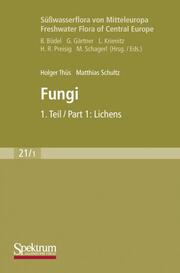Detailansicht
Fungi 1: Lichens
Freshwater Flora of Central Europe, Süßwasserflora von Mitteleuropa 21
ISBN/EAN: 9783827415943
Umbreit-Nr.: 1269713
Sprache:
Englisch
Umfang: viii, 224 S., 160 s/w Illustr., 20 farbige Illustr
Format in cm: 1.5 x 19.5 x 13
Einband:
gebundenes Buch
Erschienen am 04.12.2008
Auflage: 1/2009
- Zusatztext
- InhaltsangabePreface of the editor; - Preface of the authors; - Acknowledgements: - Introduction, Characters of Importance for Identification, Ecology of Freshwater Lichens; - General Key; - Taxonomic Treatment by Genera; - Literature; - Index - Part 2 of vol. 21 will describe other organisms classified as "fungi". Publication date is uncertain.
- Kurztext
- Volume 21 of the series "Süßwasserflora/Freshwater Flora of Central Europe" describes the aquatic fungi. The present Part 21/1 was published on 4. December 2008 and deals with freshwater lichens (symbiotic associations of a fungi with green algae or cyanobacteria), which can be found in most running water bodies with clean water and stable bedrocks. The freshwater lichen flora has a huge potential for bioindication of silting, bedrock stability, constancy of inundation and acidification. With less than 100 species, freshwater lichens are a rather small and systematically highly heterogeneous group of specialized fungi, which convergently adopted an amphibious lifestyle. They are representatives of several non related orders of Ascomycota. A comprehensive flora of Central European freshwater lichens was missing completely. This book is intended to fill that gap and to aid both the lichenologists as well as the non specialized environmentalist to efficiently and correctly identify European freshwater lichens. Detailed descriptions of all known amphibious taxa as well as photographs of most of the species are given. Keys include specialized freshwater species as well as a selection of taxa with a wide ecological amplitude, which are found at the borders of streams and lakes. In preparation is Part 21/2 covering the real fungi und fungi related micro-organisms.
- Autorenportrait
- Dr. Holger Thüs, Studium (Biologie-Diplom) an der Johannes Gutenberg Universität Mainz, anschließend Promotion an der Johann-Wolfgang-Goethe-Universität Frankfurt/M., nach der Promotion zunächst freiberufliche Tätigkeiten als Gutachter im Naturschutz, von 2003 bis 2007 Postdoc an der Technischen Universität Kaiserslautern. Seit September 2008 Kurator der Flechtensammlungen am Natural History Museum London. Forschungsgebiete: Biodiversität und Naturschutzforschung, Schwerpunkte sind z. Z. die Ökologie, Evolution und Taxonomie amphibischer Flechten. Dr. Matthias Schultz, Studium (Biologie-Diplom) an der Universität Rostock, anschließend Promotion and der Universität Kaiserslautern, seit 2001 Postdoc am Biozentrum Klein Flottbek der Universität Hamburg. Forschungsschwerpunkte sind Biodiversität, Taxonomie und Systematik cyanobakterieller Flechten.
